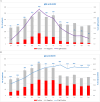Parvovirus B19 Rebound
- PMID: 40317744
- PMCID: PMC12049078
- DOI: 10.1002/jmv.70380
Parvovirus B19 Rebound
Abstract
Human parvovirus B19 (B19V) is responsible for a wide clinical spectrum ranging from asymptomatic infection, through mild disease, up to life-threatening one. Outbreaks are registered every 3-4 years, and a recent international alert for a new outbreak has been released. The experience of B19 virus circulation in a 600-bed tertiary care pediatric hospital in Rome from 2018 to 2024 is reported here. This retrospective study involved a total of 9695 blood samples (about 8500 patients), 11 amniotic fluids (11 pregnant women), and 10 827 sera (about 9500 patients), processed in the Virology Unit of Bambino Gesù Children's Hospital in Rome for B19V direct and indirect detection. In our population, the annual positivity rate for B19V DNA ranged from 0.8% in 2023 to 9.8% in 2018 and 32.8% in 2024; the same trend resulted from the analysis of the immunoglobulins M and G anti-B19V. Focusing on the last year, 314 patients resulted positive for B19V DNA detection: 204/314 (65%) had a primary infection, 150/204 (73.5%) were hospitalized, and 17/150 (11.3%) needed Intensive Care Unit (ICU) for cardiovascular, central nervous, and gastrointestinal pathologies. Two patients died from myocarditis. Among patients with the most severe clinical picture, over half had no concurring disease, and one patient died. Four amniotic fluids were positive for pregnant women who came to our observation. B19V typing of a subset of samples revealed the presence of only subtype 1A and a low intragenotypic diversity between strains from severe and mild disease. In conclusion, in 2024, a significant increase in B19V circulation was observed with profound effects on clinical outcome and consequent hospitalisation, either in patients with comorbidities or those without. This widespread circulation of the virus also had an impact on infections in pregnancy, with the known severe consequences for unborn children.
Keywords: B19 virus; epidemiology; immunoglobulin; infection; parvovirus.
© 2025 The Author(s). Journal of Medical Virology published by Wiley Periodicals LLC.
Conflict of interest statement
The authors declare no conflicts of interest.
Figures





References
MeSH terms
Substances
Grants and funding
LinkOut - more resources
Full Text Sources

